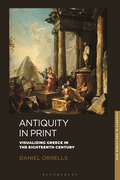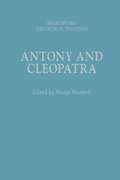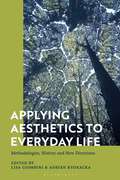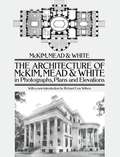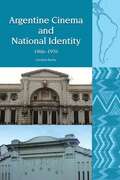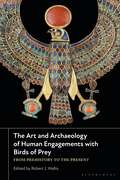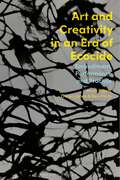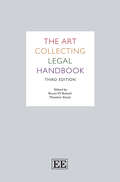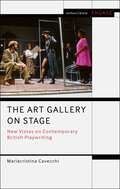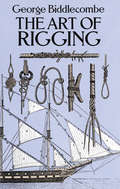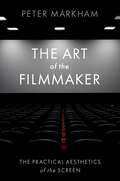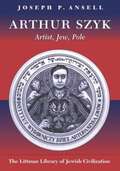- Table View
- List View
Antiquity in Print: Visualizing Greece in the Eighteenth Century (New Directions in Classics)
by Daniel OrrellsDaniel Orrells examines the ways in which the ancient world was visualized for Enlightenment readers, and reveals how antiquarian scholarship emerged as the principal technology for envisioning ancient Greek culture, at a time when very few people could travel to Greece which was still part of the Ottoman Empire. Offering a fresh account of the rise of antiquarianism in the 18th century, Orrells shows how this period of cultural progression was important for the invention of classical studies. In particular, the main focus of this book is on the visionary experimentalism of antiquarian book production, especially in relation to the contentious nature of ancient texts. With the explosion of the Quarrel between the Ancients and the Moderns, eighteenth-century intellectuals, antiquarians and artists such as Giambattista Vico, Johann Joachim Winckelmann, the Comte de Caylus, James Stuart, Julien-David Leroy, Giovanni Battista Piranesi and Pierre-François Hugues d'Hancarville all became interested in how printed engravings of ancient art and archaeology could visualize a historical narrative. These figures theorized the relationship between ancient text and ancient material and visual culture - theorizations which would pave the way to foundational questions at the heart of the discipline of classical studies and neoclassical aesthetics.
Antony and Cleopatra: Shakespeare: The Critical Tradition (Shakespeare: The Critical Tradition)
by Joseph Candido Professor Brian VickersThis new volume in the Shakespeare: The Critical Tradition series increases our knowledge of how Antony and Cleopatra has been received and understood by critics, editors and general readers. The volume provides, in separate sections, both critical opinions about the play across the centuries and an evaluation of their positions within and their impact on the reception of the play. The chronological arrangement of the text-excerpts engages the readers in a direct and unbiased dialogue, and the introduction offers a critical evaluation from a current stance, including modern theories and methods. This volume makes a major contribution to our understanding of the play and of the traditions of Shakespearean criticism surrounding it as they have developed from century to century.
Applying Aesthetics to Everyday Life: Methodologies, History and New Directions
Applying Aesthetics to Everyday Life surveys current debates in the field of everyday aesthetics, examining its history, methodology and intersections with cognate research areas. Lisa Giombini and Adrián Kvokacka bring together an international team of renowned scholars who are shaping the present and future of the discipline. They demonstrate how the historical origins of everyday aesthetics emerges across the history of Western aesthetic thought, from Renaissance thinkers to the modern German philosophers Baumgarten, Kant and Heidegger. Chapters shed light on the field's methodological underpinnings, tracing its theoretical foundations back to epistemology and ethics and assess the potential of everyday aesthetics as a theoretical tool. They reveal its interdisciplinary nature and how it assists various fields of inquiry, including environmental and urban aesthetics, conservation ethics and the philosophy of art. Through fresh explorations of its origins, background and contemporary developments, this collection advances a new definition of everyday aesthetics and provides a cutting edge reflection on the world we inhabit today.
Architectural Encounters in Asia Pacific: Built Traces of Intercolonial Trade, Industry and Labour, 1800s-1950s
Architectural Encounters in Asia Pacific explores the architecture of colonial trade and industry, revealing a complex network of transnational connections across the built heritage of the world's most dispersed and culturally diverse region. A wide-ranging collection of case studies uncover these forgotten connections, drawing together stories of migratory architects, imperial commodities, and indentured labour. From Iran to Tasmania, Japan to Java, and Imperial China to the Pacific Islands, the chapters reveal how remnants of colonial trade and industry shed light on the many multi-faceted mobilities of the imperial age, and their enduring legacy in the postcolonial built environments of Australasia, the Pacific, Southeast Asia and beyond. The chapters also reveal deep strands of cultural influences and material imprints long neglected by national histories of architecture, and showcase new methodologies to analyse the interconnectivities and bordering practices which are shaping our experiences of the 21st century. With almost every chapter arising from new archival sources, this richly interdisciplinary volume brings together the work of architectural historians, geographers and heritage practitioners to provide a new understanding of the rich and contested history of this region.
Architecture and the Public World: Kenneth Frampton (Radical Thinkers in Design)
by Kenneth FramptonArchitecture and the Public World brings together key writings by Kenneth Frampton, the eminent architectural historian and critic, from the 1980s to the present. Articles are grouped into thematic sections representing abiding concerns of Frampton's criticism: history and critical theory; modes of criticism; the vicissitudes of urban form, and tactility, tectonics, and resistance. The volume also includes a new interview with Frampton and an essay by Clive Dilnot exploring the relevance of Frampton's thought for design history and criticism.The anthology represents Frampton's abiding concern for labor and the political dimensions of architecture, including his development of the concept of 'critical regionalism', but, in featuring writings from across the range and breadth of Frampton's career, enables a broader understanding of his work, demonstrating the potential for architectural interpretation and analysis to function as a mode of cultural criticism.
Architecture, Media, Archives: The Fun Palace of Joan Littlewood and Cedric Price as a Cultural Project
by Dr Ana Bonet MiróOver 60 years on from its inception, the celebrated Fun Palace civic project – developed in the 1960s by the radical theatre director Joan Littlewood and the architect Cedric Price – continues to capture the architectural imagination. Despite the building itself never being realized, much of the previous analysis of the Fun Palace has been devoted to Price and his drawings. The critical role that Littlewood played, however, remains largely unrecognized by architectural scholarship, and a whole area of the project's cultural agenda remains overlooked.Architecture, Media, Archives is the first serious study of the complex relations between Littlewood and Price, reframing the Fun Palace as an extended media project and positioning Littlewood more clearly as co-designer. Drawing on extensive archival material, the book considers how, due to a lack of institutional support, the aims of the Fun Palace – to transform the passive mass-audiences of post-war consumer society into active citizens, through forms of self-directed, pleasure-led and open exchange – were realized through different 'sites of information' throughout the 1960s. From broadsheets, pamphlets and journals to films and press news, the book addresses the conditions of production, circulation, storage and reception of these 'sites' and reveals how they not only recorded the transformation of the project, but also fundamentally enhanced and informed its meaning in specific ways. The book also raises important questions about the agency of the Fun Palace archive in shaping the reception of the project in the decades since its inception, presenting its analysis through a novel 'Fun Palace Reception Index and Chart', fundamentally altering our view of the project itself and transforming the way in which we understand the technological and cultural production of the 1960s.
The Architecture of McKim, Mead & White in Photographs, Plans and Elevations
by Mead White McKimThe roster of McKim, Mead & White's clients reads like a who's-who of American business, professional, cultural, and social enterprise in the late nineteenth and early twentieth centuries. Many of the buildings designed by this distinguished New York firm still stand today — libraries, museums, churches, train stations, banks, office buildings, private clubs, and residences — an imposing testament to the splendor and durability of its achievement.This magnificent pictorial history is one of the most important documents in the history of American architecture. In 435 superb photographs and over 500 line illustrations, including both floor plans and elevations, it surveys over 160 structures designed by the architects of McKim, Mead & White. Originally published in four massive volumes and now available in an unabridged one-volume paperback edition, this handsome book depicts such famous New York City landmarks (present and former) as Columbia University's Low Library, the Pierpont Morgan Library, the Municipal Building, the second Madison Square Garden, and the original Pennsylvania Station.Other major landmarks include private and public buildings and other structures in Boston, Cambridge, Newport, Providence, Princeton, Philadelphia, Washington, D.C., Chicago, and Montreal. For architects and architectural historians, this book will be a valuable source for its comprehensive views of an unrivaled achievement in American architecture. Social historians and students of Americana will find it revealing for its reflection of the ideas and culture of the times. A new Introduction by Richard Guy Wilson perceptively appraises the McKim, Mead & White legacy for today's readers.
The Architecture of Steam: Waterworks and the Victorian Sanitary Crisis
by James DouetSteam pumping stations are exceptional buildings, a rousing, eloquent architecture designed by engineers, and an industrial edifice intended to express civic pride. They were invented, perfected and superseded in barely a century during the determined struggle to overcome the historic threat to urban life posed by industrialization. Of the buildings of the industrial period only train stations can compete with waterworks for stylistic bravura, carried over into the cool, tiled interiors and the sparkle and warmth of the cherished steam engine. This first comprehensive account of a remarkable fusion of machinery and structure weaves together architectural fashions, shifting social conditions and engineering inventiveness to show why such care was taken by the communities that commissioned them and by the men who built them, and what makes us take such pleasure in them today. British waterworks heritage is a global reference, for the historical significance of the sites themselves but also for the conservation of the many preserved waterworks, often extending to the reanimation of historic steam engines. No prior knowledge of architecture, sanitation or steam technology is required to enjoy this spirited and richly-illustrated account of a singular British building.
Argentine Cinema and National Identity (Liverpool Latin American Studies #16)
by Carolina RochaAn Open Access edition of this book is available on the Liverpool University Press website and through Knowledge Unlatched.Argentine Cinema and National Identity covers the development of Argentine cinema since the late 1950s to the mid-1970s, a period that has been understudied. This essential cultural history delves on the dialect tradition versus modernity that was in place during those years and also comprises an examination of the political economy of film production as well as the different laws, including that implementing censorship that regulated this cultural industry. It also pays particular attention to two historical film genres: the historical film genre per se and the gauchesque, a genre based on outlaw gauchos that was crucial for nation-building in the nineteenth century. This volume investigates the way Argentine cinema positioned itself when facing the competition of glossy American films and resorted to the historical and gauchesque to bridge the stark divisions between the Argentine left and right in the late 1960s.
The Art and Archaeology of Human Engagements with Birds of Prey: From Prehistory to the Present
Of all avian groups, birds of prey in particular have long been a prominent subject of fascination in many human societies. This book demonstrates that the art and materiality of human engagements with raptors has been significant through deep time and across the world, from earliest prehistory to Indigenous thinking in the present day. Drawing on a wide range of global case studies and a plurality of complementary perspectives, it explores the varied and fluid dynamics between humans and birds of prey as evidenced in this diverse art-historical and archaeological record. From their depictions as powerful beings in visual art and their important roles in Indigenous mythologies, to the significance of their body parts as active agents in religious rituals, the intentional deposition of their faunal remains and the display of their preserved bodies in museums, there is no doubt that birds of prey have been figures of great import for the shaping of human society and culture. However, several of the chapters in this volume are particularly concerned with looking beyond the culture–nature dichotomy and human-centred accounts to explore perspectival and other post-humanist thinking on human–raptor ontologies and epistemologies. The contributors recognize that human–raptor relationships are not driven exclusively by human intentionality, and that when these species meet they relate-to and become-with one another. This 'raptor-with-human'-focused approach allows for a productive re-framing of questions about human–raptor interstices, enables fresh thinking about established evidence and offers signposts for present and future intra-actions with birds of prey.
Art and Biotechnology: Viral Culture from CRISPR to COVID (Biotechne: Interthinking Art, Science and Design)
This interdisciplinary anthology examines the relationship between developments in biotechnology and both artistic and literary innovation, focussing in particular on how newfound molecular technologies and knowledge regimes, such as CRISPR gene editing, alter conceptions of what it means to be human.The book presents 21 essays, split across four parts, from a coterie of artists, theorists, historians and scientists which examine the symbiotic relationship between humans, animals, and viruses as well as the impossibility of germ-free existence.The essays in this volume are urgent in their topicality, embodying the exhilarating yet alarming zeitgeist of contemporary nonhuman-to-human viral transmission and gene editing technologies. Ultimately, Art and Biotechnology reveals how art and biotechnology influence each other and how art has shaped the discussion around gene editing and the socio-cultural aspects of the Covid-19 pandemic. It is essential reading for students and researchers focussing on science and art, environmental humanities, and ethics.
Art and Creativity in an Era of Ecocide: Embodiment, Performance and Practice
What can creativity achieve in an era of ecocide? How are people using creative and artistic practices to engage with (and resist) the destruction of life on earth? What are the relationships between creativity and repair in the face of escalating global environmental crises? Across twelve compelling case studies, this book charts the emergence of diverse forms of artistic practice and brings together accounts of how artists, scholars and activists are creatively responding to environmental destruction.Highlighting alternative approaches to creativity in both conventional art settings and daily life, the book demonstrates the major influence that ecological thought has had on contemporary creative practices. These are often more concerned with subtle processes of feeling, experience and embodiment than they are with charismatic 'eco-art' works. In doing so, this exploratory book develops a conception of creativity as an anti-ecocide endeavour, and provides timely theoretical and practical insights on art in an age of environmental destruction.
Art and Identity in Spain, 1833–1956: The Orient Within
by Claudia HopkinsRichly illustrated, this is the first study in English to explore the longevity of Orientalist art in Spain over a period of 120 years.It highlights how artists in Spain shaped perceptions of Al-Andalus (Iberia under Islam 711–1492) and northern Morocco, from Spain's liberal revolution of the 1830s to the end of the Protectorate of Morocco in 1956. Combining art history with a cultural studies approach, and using exemplary case studies, Hopkins foregrounds the diverse issues that underpin Orientalist expression: reflections on history and the nation, cultural nationalism, gender and sexuality, aesthetics and art commerce, colonialism and racial thinking. In the process, the book challenges over-familiar understandings of Western Orientalism.Beyond Fortuny and Sorolla, many unfamiliar artists and exhibitions are introduced, amongst them Villaamil, whose nostalgic landscapes evoked the loss of Andalusi culture; Bécquer, who celebrated Spanish-Moroccan peace-making through the lens of Velázquez; the Symbolist Rusiñol, whose images of the Alhambra are infused with melancholy; Morcillo, whose extraordinary camp images opened a new space for male subjectivity; Tapiró and Bertuchi, who dedicated their lives to Morocco, and the Moroccan Sarghini, who participated in the state-funded Painters of Africa exhibitions in Franco's Madrid – an annual exhibition that served the colonial concept of a Hispano-Moroccan brotherhood under the dictatorship.This book traces the shifting impulses and meanings of Orientalist expression in Spain. It makes an original intervention in the field of Spanish art studies and contributes new material to the ongoing debates about Western Orientalism.
The Art and Philosophy of the Garden
by David Fenner Ethan FennerThe Art and Philosophy of the Garden offers the first authoritative and comprehensive philosophical discussion of the aesthetics of gardens. Philosopher David Fenner and horticulturist Ethan Fenner address such questions as: what is a garden? Are some gardens works of art? What does it mean to appreciate gardens aesthetically? Given that gardens are always changing in a variety of ways, how is it possible to compare, evaluate, or find meaning in them? How can we interpret gardens? How do we value gardens and gardening? While grounded in Western thought, Fenner and Fenner bring to bear global ideas and examples of gardens and gardening techniques. Inspired by a surge of philosophical interest in gardening, Fenner and Fenner argue that some gardens are indeed works of art. They explore how we might understand the aesthetic properties of gardens, and focus on what it means to "read" the formal aspects of gardens -- what the authors call "garden form" -- as a basis for interpreting a garden. They discuss the intersection of gardens/gardening and value: questions such as what sort of value gardens possess; whether and how ethics are relevant to gardens; how gardens may be evaluated and compared; and the value of the practice of gardening. This comprehensive philosophical discussion on the aesthetics of gardens and gardening will not only interest those concerned with garden theory but will interest any thoughtful and intellectually curious gardener.
Art and the Young Adolescent: The Commonwealth and International Library: Painting, Sculpture and Fine Art
by Frederick PalmerArt and the Young Adolescent introduces a mode of instruction that encourages children between the ages of 11 to 15 to express themselves in artistic creation that do not necessarily represent the natural forms of things. It is intended that every kid finds enjoyment in creating works of art without being hindered by the child’s inability to create perfect replica of people and things. The book contains a list of materials and steps about such activities as collage creation, making an image by rubbing a pencil over a paper that covers a coin and tracing patterns on a paper. Selected activities are made to enhance the child’s self-expression. In addition to simple activities, possible creations of more complex projects by the child as he reached adulthood are cited in the book. The subject of the book is to increase the number of children engage in art. The text is intended for art teachers and teenagers in the art class.
The Art Collecting Legal Handbook: Third Edition
The Art Collecting Legal Handbook, now in its third edition, is a cross-border legal guide to the ever-changing maze of rules and regulations when acquiring, moving, and sharing works of art and antiquities. This new edition has been thoroughly revised and updated, and features three thematic chapters which analyse recent market trends, the development of NFTs and their reception in the art market, and the application of indirect tax. Subsequent, national chapters cover topics such as legal remedies against fakes, forgeries and counterfeits, import and export restrictions, sanctions and the rules and practices of cultural institutions and museums. With contributions from leading experts in the field, the Handbook examines the legal framework governing the collection, preservation, and promotion of cultural goods of over 25 countries around the world, written in a user-friendly question-and-answer format which allows for easy cross-jurisdictional reference. Providing a comprehensive and practical guide, this book will be an essential resource for art collectors and their advisers, alongside dealers, galleries, and museums. It will also be beneficial for lawyers specialising in commercial law, cultural heritage and art law, and intellectual property law.
The Art Gallery on Stage: New Vistas on Contemporary British Playwriting (Methuen Drama Engage)
by Mariacristina CavecchiThe Art Gallery on Stage is the first book to consider the representation of the art gallery on the contemporary British stage and to discuss how playwrights have begun to regard it as inspiration, location, focus or theme in an ever-more intense game of cross-fertilization. The study analyzes the impact on dramatic form and theatrical presentation of what has been a paradigmatic shift in the way art galleries and museums display their collections and how these are perceived, establishing a hitherto unexplored connection between modes of exhibiting and modes of representation. It traces a trajectory from plays that were initially performed in traditional theatres in accordance with a naturalistic play structure to plays that favour of a radical reconfiguration of visual representation. Indeed, since the beginning of the new millennium, playwrights and theatre-makers have increasingly experimented with new dramatic forms and site-specific venues, while forging collaborations with art makers and curators.The book focuses on plays from the 1980s onwards, such as Howard Barker's Scenes from an Execution, Nick Dear's The Art of Success, Alan Bennett's A Question of Attribution, Timberlake Wertenbaker's Three Birds Alighting on a Field and The Line, David Edgar's Pentecost, Martin Crimp's Attempt on Her Life, Rebecca Lenkiewicz's Shoreditch Madonna and The Painter, David Leddy's Long Live the Little Knife, and Tim Crouch's My Arm, An Oak Tree and England, and considers the vital contribution to the field made by set designers. Ultimately, through this study, we come to understand how modern drama can offer a set of interpretative tools to enhance our understanding of the mechanisms underlying the social construction of art and, furthermore, the potential of theatre and the gallery space to question our fundamental cultural assumptions and values.
Art, Gender and Migration in the Kurdish Diaspora: Intellectual and Cultural Production in Europe (Kurdish Studies)
by Özlem Belçim GalipThis book focuses on the cultural and intellectual activities of Kurdish migrant women through artistic and aesthetic forms of production in Belgium, France, Germany, Sweden and the UK. Using in-depth interviews with over 40 Kurdish women artists, Ozlem Galip examines how artistic, literary and cultural productions, incorporating the fields of film, theatre and music, are articulated within the structures of nation states, leading to the interrogation of the impact of western and local knowledge, patriarchy, the nation-state and globalisation. Galip also analyses how European policies affect the development of cultural engagement of Kurdish migrant women, and how such engagements help these women to integrate into European society.Examining the gendered experiences of diaspora from all four regions of Kurdistan; Iraq, Iran, Syria and Turkey, this book challenges ideas about gender, migration and art through the lens of women artistic production with a focus on women-led activism and the changing integration and migration policies of Europe.
Art Nouveau Graphic Masterpieces: 100 Plates From "La Decoration Artistique" (Calla Editions)
by Henry GuedyPublished in Paris before World War I, these decorative Art Nouveau graphics originally appeared in a now-rare periodical, La Decoration Artistique. This compilation presents 100 full-color plates in a beautiful assortment of period designs that will prove essential to collectors of the era's best and hardest-to-find illustrations. A splendid variety of images includes headpieces, typographical banners, and other designs rendered in the distinctive Art Nouveau style, all embellished with naturalistic motifs, from parrots and peacocks to sinuous vines and flowers in full bloom. Other illustrations feature storefront signage for bakeries and cafés; decorative friezes of theatrical masks and grapevines; borders of blossoms, books, and birds; stenciled decorations for fire screens; and corner and ceiling ornaments. Art aficionados, designers, artists, art students, and anyone with a taste for Art Nouveau will delight in this extraordinary collection, which offers a lasting source of inspiration and pleasure.
The Art of Mary Linwood: Embroidery, Installation, and Entrepreneurship in Britain, 1787-1845 (Material Culture of Art and Design)
by Dr. Heidi A. StrobelThe Art of Mary Linwood is the first book on Leicester textile artist Mary Linwood (1755-1845) and catalogue of her work. When British textile artist and gallery owner Mary Linwood died in 1845 just shy of 90 years old, her estate was worth the equivalent of £5,199,822 in today's currency. As someone who made, but did not sell, embroidered replicas of famous artworks after artists such as Gainsborough, Reynolds, Stubbs, and Morland, how did she accumulate so much money? A pioneering woman in the male-dominated art world of late Georgian Britain, Linwood established her own London gallery in 1798 that featured copies of well-known paintings by these popular artists. Featuring props and specially designed rooms for her replicas, she ensured that her visitors had an entertaining, educational, and kinetic tour, similar to what Madame Tussaud would do one generation later. The gallery's focus on picturesque painters provided her London visitors with an idyllic imaginary journey through the countryside. Its emphasis on quintessentially British artists provided a unifying focus for a country that had recently emerged from the threat of Napoleonic invasion.This book brings to the fore Linwood's gallery guides and previously unpublished letters to her contemporaries, such as Birmingham inventor Matthew Boulton and Queen Charlotte. It also includes the first and only catalogue of Linwood's extant and destroyed works. By examining Linwood's replicas and their accompanying objects through the lens of material culture, the book provides a much-needed contribution to the scholarship on women and cultural agency in the early 19th century.
The Art of Rigging
by George Biddlecombe"Few, today, can realize how important was the art of rigging a ship and reeving her gear in the days just old when all aloft was wood and hemp; or how great the part it has played in the building of Empire." — Introduction.Although mastery of the art of rigging is no longer required on board today's ships, legions of serious model ship builders who wish to rig their ships correctly need to learn the art in miniature. This book is widely considered the best manual ever produced on rigging the sailing ship. It is based on the extensively revised and updated 1848 edition prepared by Captain George Biddlecombe, a Master in the Royal Navy and former merchant seaman. The book is divided into five parts:The First Part contains an alphabetical explanation of terms and phrases used in rigging. The Second Part consists of directions for the performance of operations incidental to rigging and preparing it on shore, with a table of the comparative strength of chain and rope. The Third Part contains the progressive method of rigging ships. The Fourth Part contains a description of reeving the running rigging and bending the sails in addition to the rigging of brigs, yachts, and small vessels. The Fifth Part comprises tables of the quantities and dimensions of the standing and running rigging of ships, brigs, fore-and-aft schooners, and cutters, with the species, size, and number of blocks, hearts, dead-eyes, etc.Serious modelists, naval historians, armchair skippers — any sailing buff — will want to own a copy of The Art of Rigging. Complete and wonderfully clear, it is now available in its first inexpensive paperback edition. It belongs in every maritime library.
The Art of Teaching Philosophy: Reflective Values and Concrete Practices
Teaching is a moral enterprise through which we reflect our most deeply held values. Thoughtful teaching begins before the syllabus is written and continues well beyond the end of the semester. In this book a team of over 30 renowned and innovative US philosophy teachers offer accessible reflections and practical suggestions for constructing a philosophy course. Our classroom can mimic dynamics that emerge in the broader society, or it can teach students new ways of engaging with one another. From syllabus design and classroom management to exercises and assessments, each chapter answers frequently asked questions: How do we balance lecture with discussion? What are our goals? When we're leading a discussion and a student (or several students) say false things, what should we do? What are the costs of correcting them? Here is an in-depth exploration of topics such as content selection, assessment design, mentorship, and making teaching count professionally. Each contribution balances reflective values with concrete advice emerging from tried-and-tested practices. Insightful discussions about theories of philosophy pedagogy feature throughout. Divided into The Philosophy Course, The Philosophy Classroom, Exercises and Assignments, and What Comes Next, chapters include insights from students on what they have learned from studying philosophy. For teachers of philosophy at any stage of their career this is a must-have resource.
The Art of the Filmmaker: The Practical Aesthetics of the Screen
by Peter MarkhamThe Art of the Filmmaker: The Practical Aesthetics of the Screen explores the filmmaker's intention and method, their creation and capture of the fiction on the screen, and their formulation of the elements of the frame as a designed address to the audience. Positing 'practical aesthetics' as a resource of visual communication central to cinematic art, this book examines the concepts fundamental to the selective processes of the filmmaker and offers the reader highly informed textual analyses of specific films to explain the how and why of cinematic decision-making. After general consideration of language and cinema, Peter Markham sets out categories essential to the reader in their understanding of the filmmaker's art: dramatic narrative, elements before the lens, screen language, the shot, camera, editing, sound and music. Furthermore, Markham provides insight into how a comparison of the film with its screenplay can reveal the evolution of the filmmaker's storytelling strategies. This book also includes case studies of scenes and sequences from three films by contemporary filmmakers: Hereditary (Ari Aster), Moonlight (Barry Jenkins), and Nomadland (Chloe Zhao). Screenshots are used to illustrate the concepts articulated in the carefully constructed text. This book is intended for the student of filmmaking, its practitioners, students and scholars of film studies and film theory, for those in media studies and arts programs, and for lovers of movies.
The Art of Winnie-the-Pooh: How E. H. Shepard Illustrated an Icon
by James CampbellWinnie the Pooh and his friends from the Hundred Acre Wood are some of the world’s most beloved characters in children’s literature. But before they appeared in many millions of books and in nearly fifty languages, they started life in the 1920s as the product of a unique collaboration between A. A. Milne and E. H Shepard; author and illustrator wove images and text together in a way that was utterly original for the time. For Shepard, it was a process that he relished, creating artwork for new editions right up until his death in 1976 at the age of ninety-six.In this beautifully presented, full-colour volume, readers will not only discover the story behind this remarkable partnership, but also follow the evolution of Shepard’s work, from those first tentative sketches through to the illustrations we know and love, and even on to the characters’ later incarnations at Disney.Presenting over 150 full colour images – including never-before-published sketches, finished artwork, personal family photographs and memorabilia – this is the perfect gift for those of us who grew up loving the books.
Arthur Szyk: Artist, Jew, Pole (The Littman Library of Jewish Civilization)
by Joseph P. AnsellArtist and illustrator Arthur Szyk was a Polish Jew whose work was overwhelmingly Jewish in theme and content. In a lifetime of creativity that spanned many of the major events of the twentieth century and took him from Poland to France, England, and the United States, the mission he set himself was to use his artistic talents to serve humanity and the Jewish people. Though his politics were dictated by what he thought would be good for the Jews, his work as a political artist went well beyond a narrow definition of the Jewish cause. He is best known among Jews for his illustrated Haggadah, but the overwhelming majority of his work deals with contemporary political themes and social causes. In his native Poland, Szyk promoted the causes of freedom, toleration, and human dignity, drawing his inspiration from the Old Testament. He believed that as a Jewish artist he had a responsibility to speak for all minorities. His famous illustration of the historical Statute of Kalisz symbolized his belief that the newly re-established Polish state would welcome all its citizens into full and equal participation. Even though at that time he was already based outside Poland, he worked for many years on behalf of the Polish government in an effort to strengthen the Jews’ position. Szyk left Europe in 1940 and arrived in the United States via Canada later the same year. Determined as ever to use his art for political purposes, he crusaded against the Nazis through newspaper and magazine cartoons, posters and public exhibitions. Convinced that Hitler would not stop with the Jews but would suppress all freedom-loving people, he supported the war effort through his striking propaganda images of the German and Japanese armies, to great effect. After the war he turned his efforts to promoting the idea of a Jewish homeland in Israel. In every phase of his career, one finds Szyk looking to the past but hoping for the future; he believed that art could make a difference in the world, politically and socially. Joseph Ansell’s biography makes a singular contribution to the history of Jewish art and of Polish-Jewish relations in the first half of the twentieth century.
